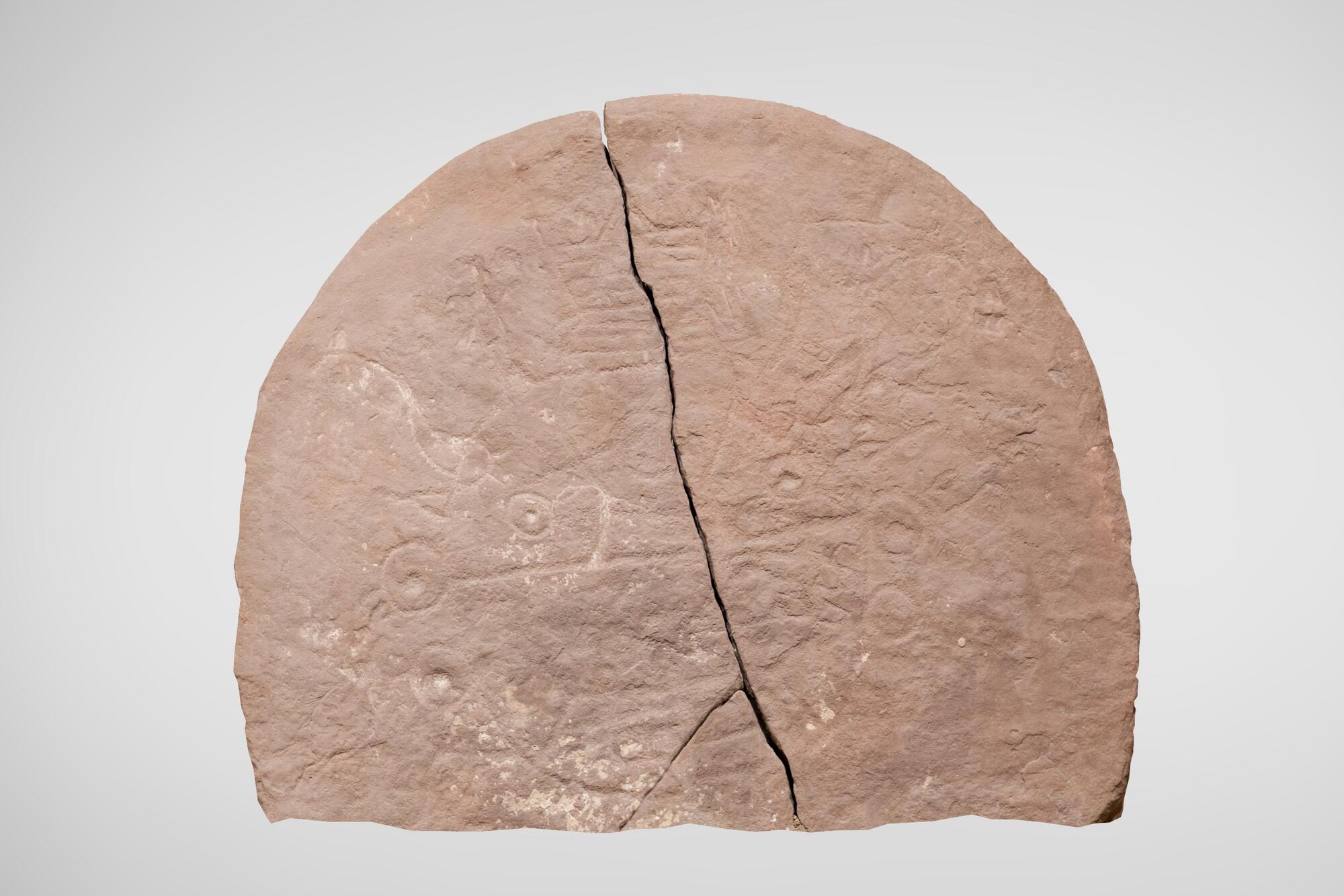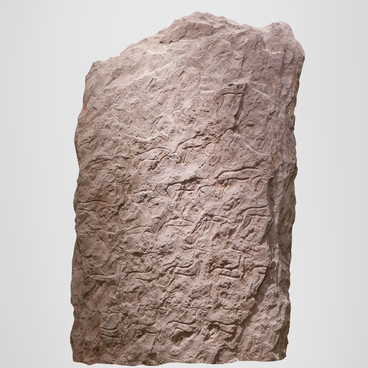A slab of red sandstone was found in the middle reaches of the Karysh River, not far from the former geological base in the Shirinsky region of Khakassia. It was transported to the village of Malaya Syya, and then transferred to the Shirinsky Museum, and in 2010, it became part of the collection of the Khakassia National Museum.
The slab dates from approximately the end of the 3rd — the beginning of the 2nd millennium BC, that is, the period of the Okunev archaeological culture. It was at this time that most of the famous Khakass masks were created —anthropomorphic images on stone statues. All of them had different sizes and varying degrees of detail: there were both primitive drawings of lines and dots, and elaborate relief images that were close to real human appearance or endowed with fantastic features.
The slab has a rounded shape; traces of rough processing have been preserved on its edges. Two cracks — one small, the second going through the entire surface of the slab — divide it into three unequal parts.
In the center, a complex three-eyed mask is engraved on the stone: it probably denoted a deity from ancient Khakass myths. The two eyes are outlined by circles with dots in the center. The third, which is located in the middle of the forehead, does not have a dot. The mouth, like most similar images, is an oval depression, and the nostrils are two small circular indentations.
Between the eyes and mouth is a horizontal line that divides the face across the face into two parts. Two vertical wavy lines descend from the forehead to it: they indicate the location of the nose, and also separate the image of the third eye from the rest of the drawing.
From the outer edge of the mask, snakes carved in stone with open mouths stretch to the eyes. Their tails go beyond the contour of the face and turn into bull horns. Another schematic image of a snake is located between the mouth and nostrils.
On either side of the mask, two circles with dots in the center are carved on the stone. Also on the slab you can see drawings of bull ears and horns, triangles that turn into rhombuses with split ends. Probably, in this way the master schematically depicted the spearheads with a fork in the form of a serpentine sting. It was believed that the identification of a weapon with a poisonous reptile gives it special strength.
The slab dates from approximately the end of the 3rd — the beginning of the 2nd millennium BC, that is, the period of the Okunev archaeological culture. It was at this time that most of the famous Khakass masks were created —anthropomorphic images on stone statues. All of them had different sizes and varying degrees of detail: there were both primitive drawings of lines and dots, and elaborate relief images that were close to real human appearance or endowed with fantastic features.
The slab has a rounded shape; traces of rough processing have been preserved on its edges. Two cracks — one small, the second going through the entire surface of the slab — divide it into three unequal parts.
In the center, a complex three-eyed mask is engraved on the stone: it probably denoted a deity from ancient Khakass myths. The two eyes are outlined by circles with dots in the center. The third, which is located in the middle of the forehead, does not have a dot. The mouth, like most similar images, is an oval depression, and the nostrils are two small circular indentations.
Between the eyes and mouth is a horizontal line that divides the face across the face into two parts. Two vertical wavy lines descend from the forehead to it: they indicate the location of the nose, and also separate the image of the third eye from the rest of the drawing.
From the outer edge of the mask, snakes carved in stone with open mouths stretch to the eyes. Their tails go beyond the contour of the face and turn into bull horns. Another schematic image of a snake is located between the mouth and nostrils.
On either side of the mask, two circles with dots in the center are carved on the stone. Also on the slab you can see drawings of bull ears and horns, triangles that turn into rhombuses with split ends. Probably, in this way the master schematically depicted the spearheads with a fork in the form of a serpentine sting. It was believed that the identification of a weapon with a poisonous reptile gives it special strength.



